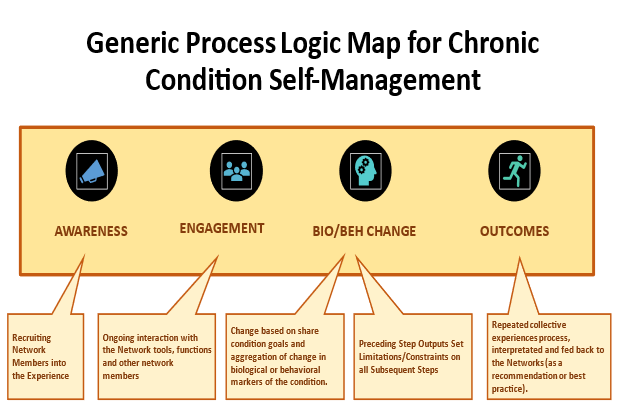Healthcare is being increasingly challenged by 4 growing global trends. The first is an aging global population who’s functional and healthcare needs high prevalence of comorbidities (aka chronic care management needs) grow exponentially with each aging year. A complicating matter is the poor outcomes evidence base and clinical trials for coordinated care when two or more chronic conditions are present. The second is a growing shortage of practitioners is key healthcare roles including but not limited to primary care and mental health. This shortfall coupled with the increasing need of an aging species requires a system that can scale services and integrate key practitioners and clinical care and related data across time, space, and specialty. The third challenge is the growing recognition that the randomized clinical trial methodology and the phased approach to drug (and other form of treatment) development is a necessary but insufficient approach to evaluation of efficacy and effectiveness of any given experimental treatment test. The increasing clinical and market relevance (including energy and resources devoted to such activities) for post approval observation periods and the collection of “real-world data” at tests this shortcoming. For example, in the U.S the FDA has required (in some cases) or pharma manufacturers have embraced the need to fill those clinical and product knowledge gaps by implementing further clinical monitoring and metrics. Other supporting trends include FDA process and approval changes, including inclusion of “adaptive” designs and N-of-1 evaluation intended to both expedite approvals to match the innovation curve and to complimentarily explore the value of other methodological approaches (citations). Lastly, is the consequent need to scale health care delivery beyond the face-to-face visit.
This has become an imperative because the face-to-face component of care has become an increasingly “rate-limiting” step in addressing a growing clinical need. This is NOT to suggest elimination of the human aspect of care but rather that a more intentional and practical approach to the augmentation and integration of care extenders is in order. The pandemic has both challenged and changed health and health care delivery at a global scale. A critical portion of this change has been the experience with and the perception of the clinical value, practicality of remote care that is digitally enhanced for both doctor and patient. What have we learned from this experience?
If connected care is “the real-time, electronic communication between a patient and a provider, including telehealth, remote patient monitoring, and secure email communication between clinicians and their patients”1 then when properly applied, connected care creates a high value remote interaction strategy with patients using commercially available digital health technologies with demonstrable clinical and economic effectiveness. This connected approach leverages their patient’s data to help connect and extend clinical care over distance and time (synchronous and asynchronous availability) with much more granular time-series data that better reflects the patient’s actual treatment response course and related behavioral factors.
How can digital health technologies help meet these four challenges? In the goal and intention of this proposed special issue we would solicit manuscripts that address just what lessons have we are learning and how we apply them to the challenges above. Examples of successes (and failures) in implementing digital health tools and processes in a real clinical context (clinical workflow) is a critical step in the development of practical, applied, data driven approaches to scalable and remote care (and the business models that would support them).
Areas for Potential Learning (and perhaps Publication Themes) might include but not be limited to:
- The need for better and more rapid development and testing of treatments (test treatments with fewer patients, develop greater statistical power, with no risk to internal validity.
- Development and testing of distribution of approved medications and long-term monitoring programs for better real-world data collection and interpretation.
- Case Studies/Case Series using commercially available technologies for better care and outcomes.
- Innovations in both process and outcomes evaluation of clinical digital technologies.
- Ethical, cultural and/or infrastructure issues related to the user of digital technologies
- The value and necessity of a remote care infrastructure including care delivery, reimbursement models, credentialling/licensure, outcomes, and economics evaluation.
- Human-centered design in clinical and digital health care.
- Digital health applications in pharmacogenomics.
- Digital Aging in Place.
- Alliance of Connected Care. http://www.connectwithcare.org/what-is-connected-care/.






